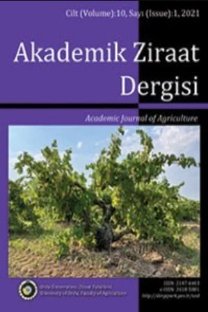Root-knot nematode Meloidogyne arenaria infecting Swiss Chard (Beta vulgaris subsp. cicla)
Beta vulgaris subsp cicla, Root knot nematodes, Meloidogyne arenaria, Swiss chard
___
Adam, M. A. M., Phillips, M. S., & Blok, V.C. (2007). Molecular diagnostic key for identification of single juveniles of seven common and economically important species of root-knot nematode (Meloidogyne spp.). Plant Pathology, 56, 190-197.Akyazı, F., Han, H., Çetintaş, R., &Felek, A. F. (2012). First report of root-knot nematodes, Meloidogyne arenaria and M. hapla (Nemata: Meloidogynidae) from pepino in Turkey. Nematologia Mediterranea, 40(2), 107-110.
Aydınlı, G., & Mennan, S. (2016). Identification of root-knot nematodes (Meloidogyne spp.) from greenhouses in the Middle Black Sea Region of Turkey. Turkish Journal of Zoology, 40, 675-685.
Bastidas, M. R., Curiel M.G. M., Fasio A. C., Contreras M. R., Rubio J. S. H. & Osuna J.de D.D. (2019). Identification and distribution of Meloidogyne species in Baja California Sur, Mexico. Revista Mexicana de Ciencias Agrícolas. 10(2), 337-349. Biancardi, E., Panella, L. W. & Lewellen, R. T. (2011). Beta maritima, the origin of beets. Springer Science & Business Media.294 p.
Çetintaş, R. & Çakmak, B. (2016). Meloidogyne species infesting tomatoes, cucumbers and eggplants grown in Kahramanmaraş Province, Turkey. Turkish Journal of Entomology, 40(4), 355-364.
Decker, H. (1989). Plant Nematodes and Their Control, Phytonematology ( Ed. N.M. Sveshnicova). E. J. Brill (Usa). Printed in India at Pauls Press, New Delhi. Sf 262 den . 540 pp.
Devran, Z., & Söğüt, M. A. (2009). Distribution and identification of root-knot nematodes from Turkey. Journal of Nematology, 41(2), 128-133.
Eppo, 2019. European and Mediterranean Plant Protetion Organization. https,//www.eppo.int/ (15.11.2019).
Kareem, K. H., Ahmed, N. H., Gürkan, T., Akbay, N. G., Salai, S. A. F., & Çetintaş, R. (2017). Diagnosis of Nematode Populations Found in Chard, Barley and Onion Grown in North of Iraq and South of Turkey. Kahramanmaraş Sütçü İmam Üniversitesi Doğa Bilimleri Dergisi, 20(1), 28-34.
Kaşkavalcı, G., & Öncüer, C. (1999). Investigations on distribution and economic importance of Meloidogyne goeldi, 1887 (Tylenchida, Meloidogynidae) species found in the major areas of hot climate vegetables in Aydın province. Turkish Journal of Entomology, 23(2), 149-160.
Lange, W, Brandenburg W. A., & De Bock TSM (1999). Taxonomy and cultonomy of beet (Beta vulgaris L.). Bot J Linn Soc.130, 81-96. Martin, G. C. (1959). Plant species attacked by root-knot nematodes (Meloidogyne spp.) in the Federation of Rhodesia and Nyasaland. Nematologica, 4(2), 122-125.
McGrath, J. M., Panella, L., & Frese, L. (2011). Beta (p,1-29) In, Kole, C. (2011). Wild Crop relatives, genomic and breeding resources, Industrial crops. Springer.
Millán de Aguirre, J. R. (1991). Especies del género Meloidogyne presentes en los cultivos de la C. A. Vasca. Estudios de Fitopatología. S E F. Consejería de Agricultura, Badajoz, Spain, 164-167.
Ninfali, P., & Angelino, D. (2013). Nutritional and functional potential of Beta vulgaris cicla and rubra. Fitoterapia, 89, 188-199.
Norton, P. B., & Esposito, J.J. (1994). The New Encyclopaedia Britannica Encyclopedia Britannica Inc., Chicago
Pagan, C., Coyne, D., Carneiro, R., Kariuki, G., Luambano, N., Affokpon, A., & Williamson. V. M. (2015). Mitochondrial haplotype-based identification of ethanol-preserved root-knot nematodes from Africa. Phytopathology, 105(3), 350-357.
Philis, J. (1983). Occurrence of Meloidogyne spp. and races on the island of Cyprus. Nematologia Mediterranea, 11, 13-19.
Özarslandan, A., & Elekçioğlu, İ. H. (2010). Identification of the Root-knot nematode species (Meloidogyne spp.) (Nemata, Meloidogynidae) collected from different parts of Turkey by molecular and morphological methods. Turkish Journal of Entomology, 34(3), 323-335.
Söğüt, M.A., & Elekçioğlu, İ.H. (2000). Determination of Meloidogyne goeldi, 1892 (Nemata, Heteroderidae) species races found in vegetable growing areas of the Mediterranean region of Turkey. Turkish Journal of Entomology, 24(1), 33-40.
Stanton, J., Hugall, A., & Moritz, C. (1997). Nucleotide polymorphisms and an improved PCR-based mtDNA diagnostic for parthenogenetic rootknot nematodes (Meloidogyne spp.). Fundamental Applied Nematology, 20(3), 261-268.
Taylor, A. L., Sasser, J. N. & Nelson, L. A. (1982). Relationship of climate and soil characteristics to geographical distribution of Meloidogyne Species in agricultural soils. IMP, contract No. AID/ta-c-1234, Raleigh, North Carolina, U.S.A.
Trudgill, D. L., & Blok, V. C. (2001). Apomictic Polyphagous Root Knot Nematodes, Exceptionally Successful and Damaging Biotrophic Root Pathogens. Annual Review Phytopathology, 39(1), 53-77.
TUİK. (2019). Türkiye İstatistik Kurumu. http,//www.tuik.gov.tr/UstMenu.do?metod=istgosterge (10.10.2019). Uysal, G., Söğüt, M. A., & Elekçioğlu, İ. H. (2017). Identification and distribution of root-knot nematode species (Meloidogyne spp.) in vegetable growing areas of Lakes Region in Turkey. Turkish Journal of Entomology, 41(1),105-122.
Zijlstra, C., Donkers-venne, D. T. H. M., & Fargette, M. (2000). Identification of Meloidogyne incognita, M. javanica and M. arenaria using sequence characterised amplified region (SCAR) based PCR assays. Nematology, 2(8), 847-853.
- ISSN: 2147-6403
- Yayın Aralığı: 2
- Başlangıç: 2012
- Yayıncı: Ordu Üniversitesi Ziraat Fakültesi
Nohut ununun tavuk köfte üretiminde kullanımı
Yapısal ve çevresel faktörlerin konut fiyatlarına etkisi: Ordu kent merkezi örneği
Mesut GÜZEL, Pervin YEŞİL, Elif Gülderen GÜZEL
Farklı potasyum gübre formları ve oranlarının brokoli bitkisinin kadmiyum alımı üzerine etkileri
Yulafta (Avena sativa L.) çinkolu gübrelemenin verim ve verim ögeleri üzerine etkisi
Armutta fidan kalitesi üzerine anaç ve çeşitlerin etkisi
Mahlep (Prunus mahaleb) meyvesinin kuruma kinetiği ve renk değişimi
Hakan POLATCI, Muhammed TAŞOVA, Gazanfer ERGÜNEŞ, Gülşen KIRMIK
Hatice BİLİR EKBİÇ, Seda KOŞAR
Karabuğday bitkisinde bor alınımı ve toksitesi üzerine potasyum uygulamalarının etkisi
Büyükbaş hayvancılık sektöründe üretici profili ve işletme yapısı:TRA2 Bölgesi örneği
Pazı (Beta vulgaris subsp. cicla ) bitkisi zararlısı kök-ur nematodu Meloidogyne arenaria
